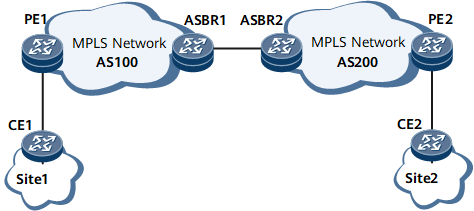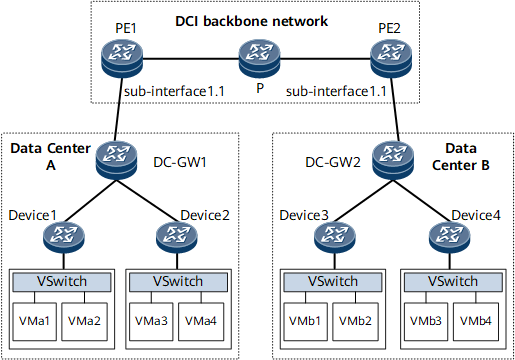Configuring an EVPN to Carry Layer 3 Services
On DCI and IP RAN networks, you can configure EVPN functions to carry Layer 3 services.
Usage Scenario
On a traditional network, the BGP/MPLS IP VPN function is used to carry Layer 3 services. To additionally carry Layer 2 services, users have to deploy an L2VPN over the existing network, which increases deployment and O&M costs. To address this problem, users can deploy an EVPN to carry Layer 3 services. To additionally carry Layer 2 services, users only add some EVPN configurations, implementing the bearer of both Layer 2 and Layer 3 services.
Intra-AS mutual VPN communication
On the network shown in Figure 1, the VPNs at Site 1 and Site 2 need to communicate with each other through a public MPLS network. To implement this communication, perform the following configurations:Configure an L3VPN instance on each PE to manage VPN routes.
Establish a BGP EVPN peer relationship between the PEs to transmit EVPN routes carrying VPN routes.
Establish an IGP neighbor relationship or BGP peer relationship between each PE and CE at the access side to mutually transmit VPN routes.
Inter-AS mutual VPN communication
On the network shown in Figure 2, the VPNs at Site 1 and Site 2 need to communicate with each other through two public MPLS networks in different ASs. To implement this communication, perform the following configurations:Configure an L3VPN instance on each PE to manage VPN routes.
Establish IBGP EVPN peer relationships between PEs and ASBRs and an EBGP EVPN peer relationship between the ASBRs to transmit EVPN routes carrying VPN routes between the PEs.
Establish an IGP neighbor relationship or BGP peer relationship between each PE and CE at the access side to mutually transmit VPN routes.
DCI network
The EVPN function applies to traditional DCs that interconnect through a DCI network. On the network shown in Figure 3, DC-GWs and DCI-PEs are separately deployed. The DCI-PEs consider the connected DC-GWs as CEs, receive VM IP routes from the DCs through a routing protocol, and save and maintain the received routes. Deploying an EVPN over the DCI backbone network allows VM IP routes to be transmitted between DCs, implementing inter-DC VM communication. To implement this communication, perform the following configurations:Configure an L3VPN instance on each PE to manage VM IP routes.
Establish an IBGP EVPN peer relationship between the PEs to transmit EVPN routes carrying VM IP routes.
Establish an IGP neighbor relationship or BGP peer relationship between each PE and DC-GW to mutually transmit VM IP routes.
L2VPN accessing L3VPN
In L2VPN accessing L3VPN scenarios, EVPN can be used as a substitute for BGP VPNv4 to function as the control plane of an L3VPN. For details about the method of configuring the L2VPN and stitching devices, see L2VPN Accessing L3VPN Configuration. For details about the method of configuring the L3VPN, see the corresponding information in this section.
Pre-configuration Tasks
Before configuring an EVPN to carry Layer 3 services, ensure Layer 3 route reachability on the IPv4 network.
- Configuring an L3VPN Instance
- You can configure an L3VPN instance to store and manage received VPN routes or VM routes.
- Configuring BGP EVPN Peer Relationships
- You can configure BGP EVPN peer relationships between PEs or between PEs and ASBRs as required to mutually transmit EVPN routes between the PEs. Additionally, you can configure BGP RRs to minimize the number of BGP EVPN peer relationships, saving network resources.
- Configuring Route Exchange Between a PE and an Access-side Device
- PEs and access-side devices can communicate through BGP, static routes (including default routes), or IGP. Configure route exchange between a PE and an access-side device according to your network plan.
- (Optional) Re-Encapsulating IRB (v6) Routes into the desired Routes
- If you want to convert the IRB routes carrying the network segment address of a tenant host that are received by a device into host IP prefix routes or ARP routes, or convert the IRBv6 routes carrying the IPv6 network segment address of a tenant host that are received by a device into host IPv6 prefix routes or ND routes, you must enable the device to re-encapsulate IRB or IRBv6 routes into the desired routes.
- Verifying the Configuration of an EVPN to Carry Layer 3 Services
- After configuring an EVPN to carry Layer 3 services, check the configurations.


